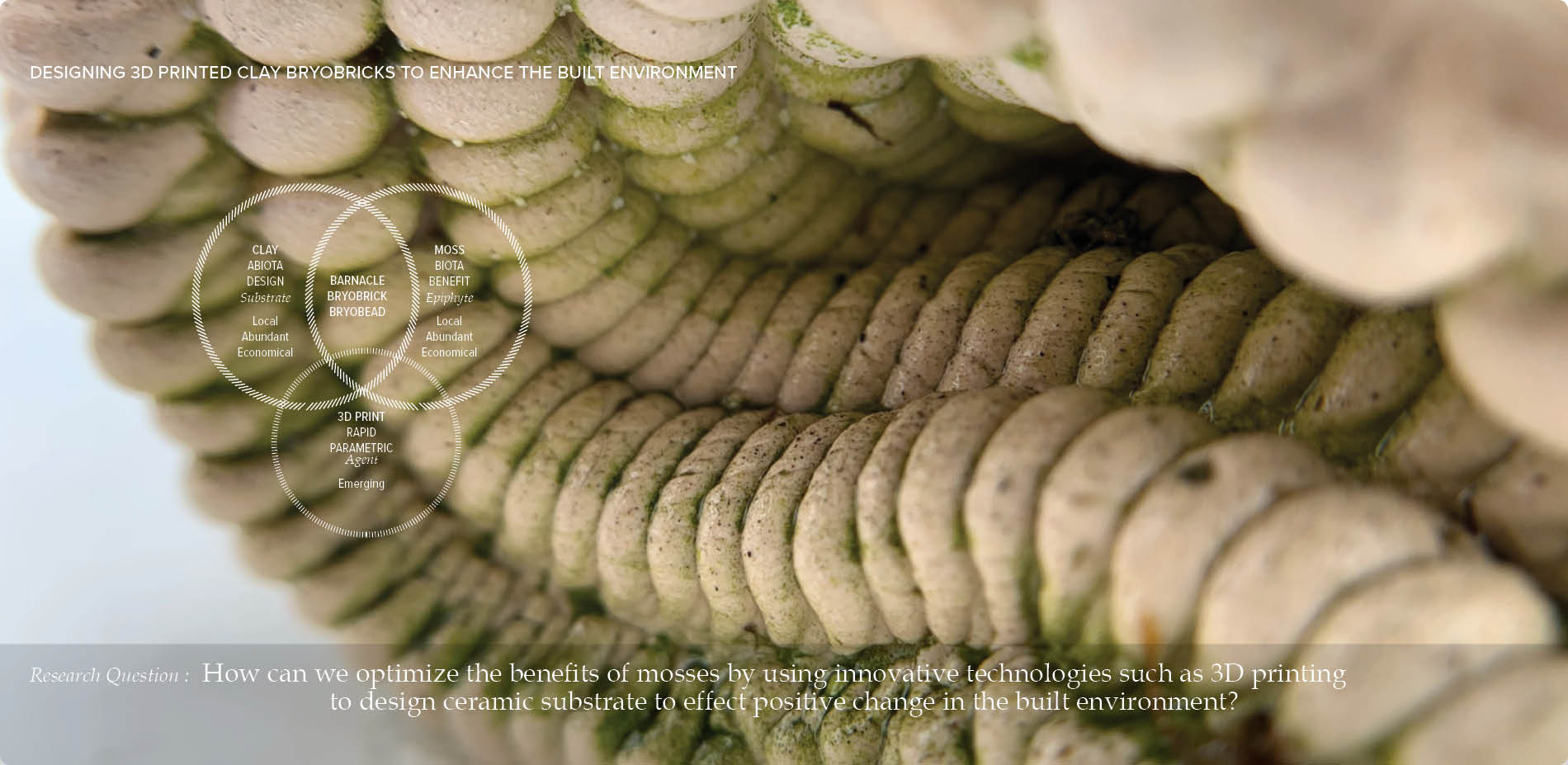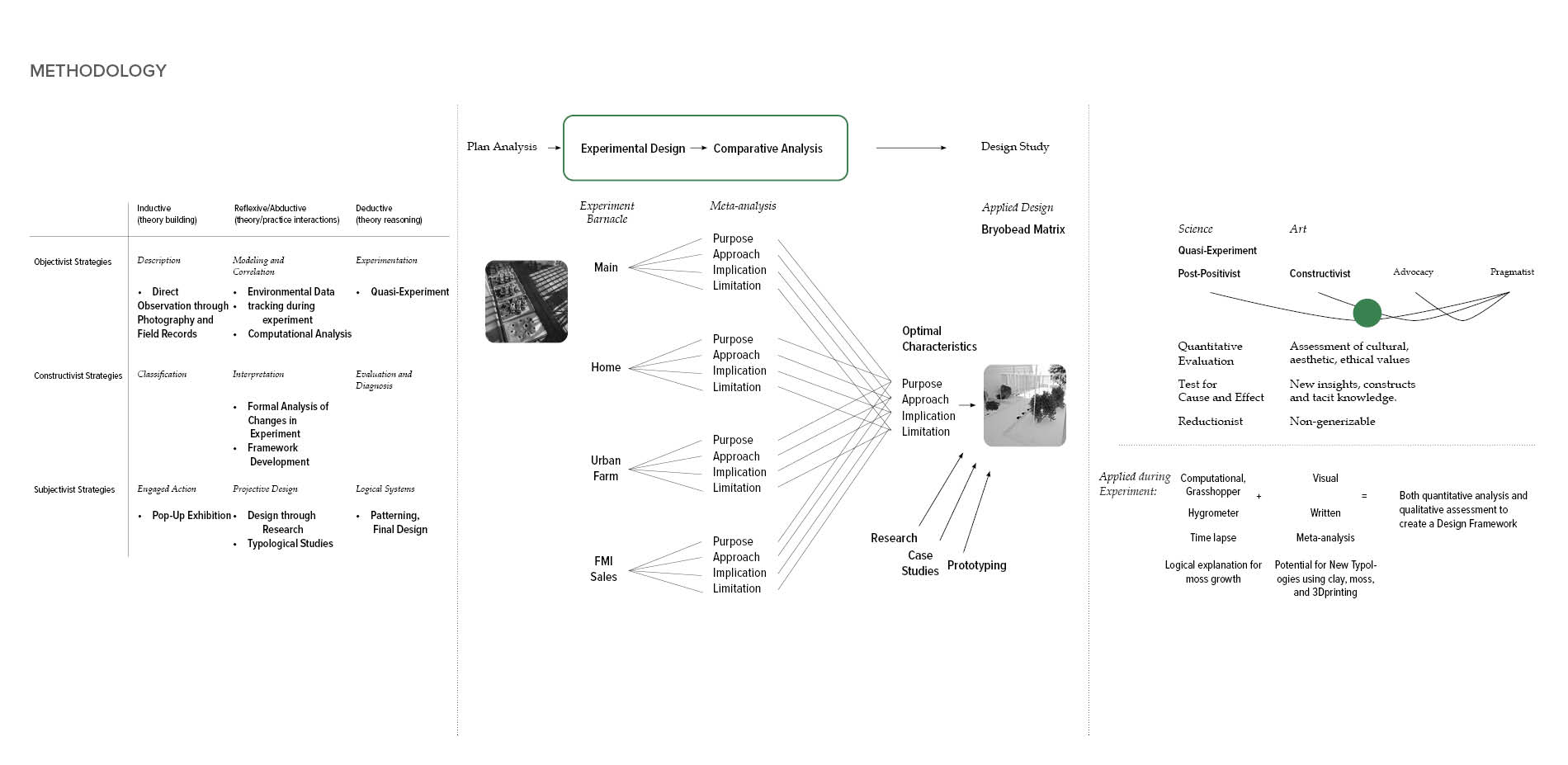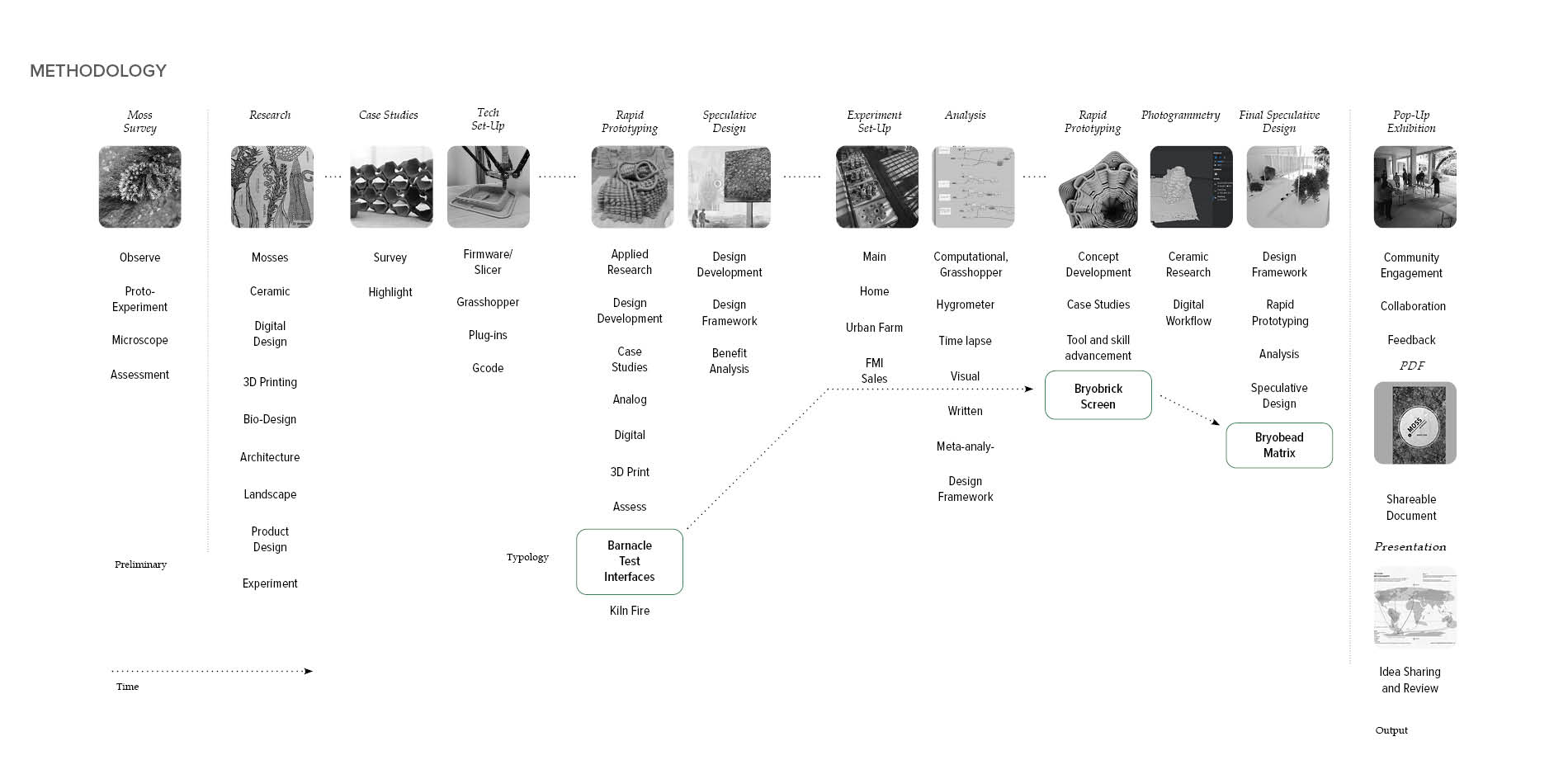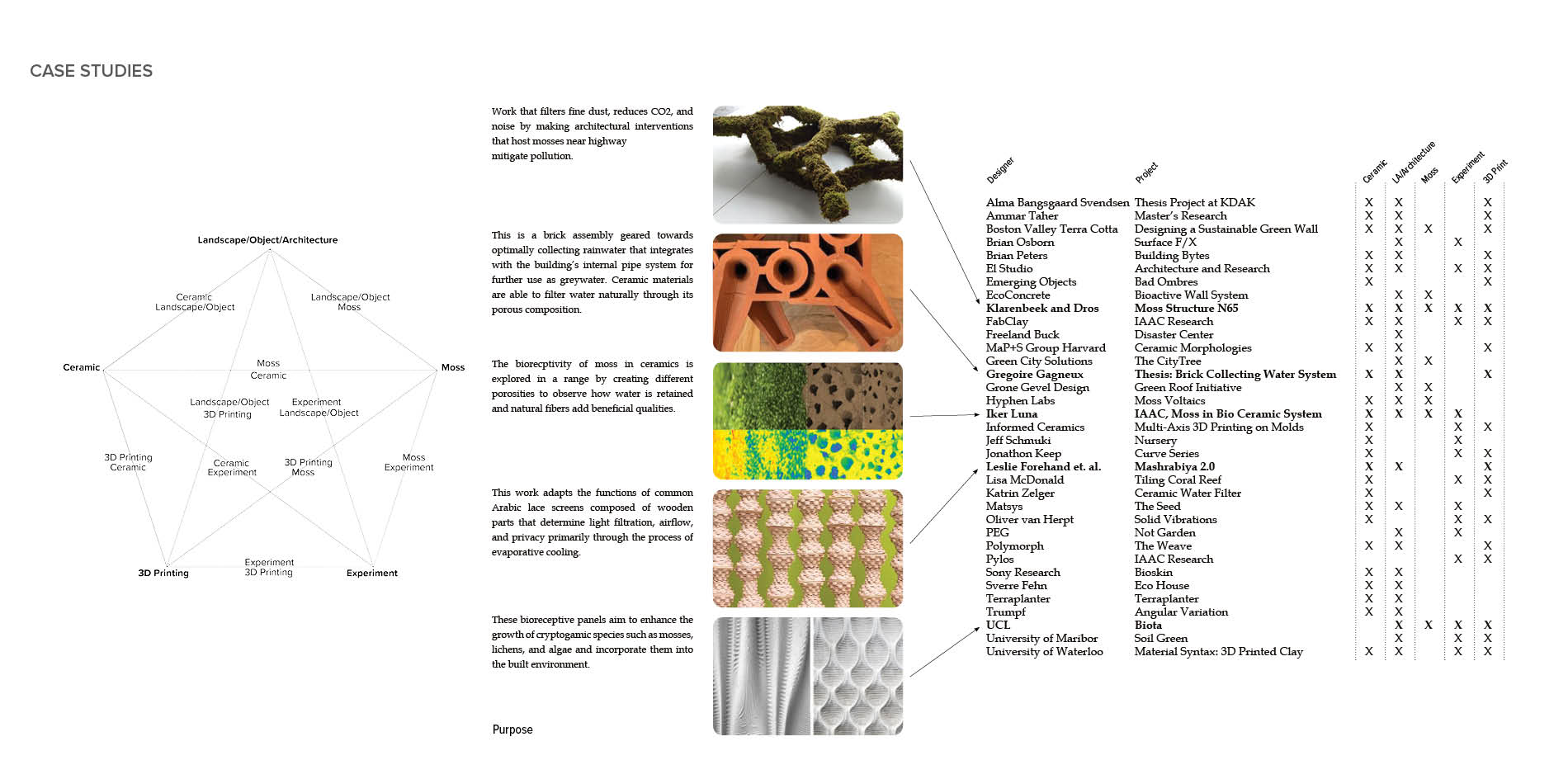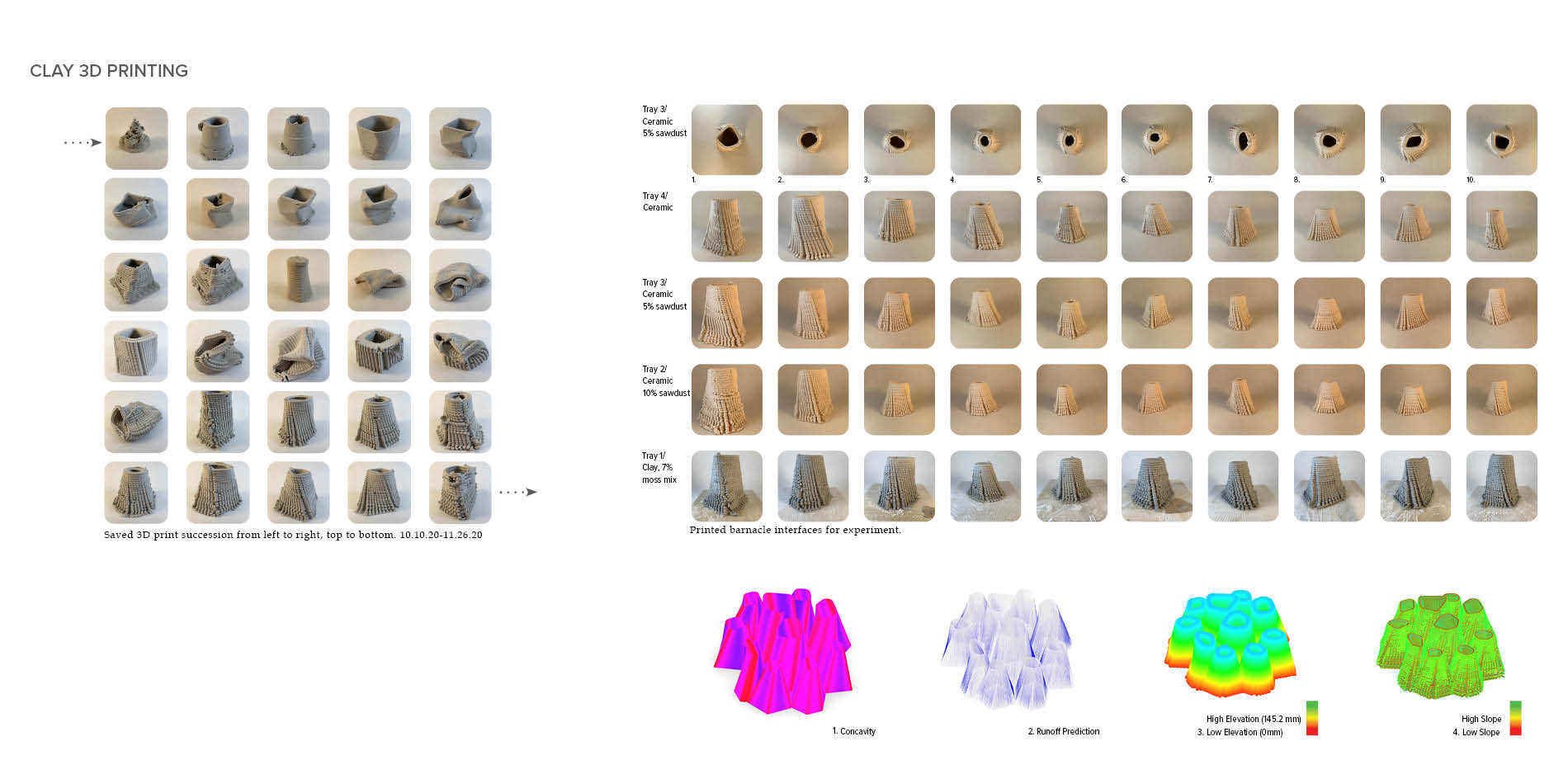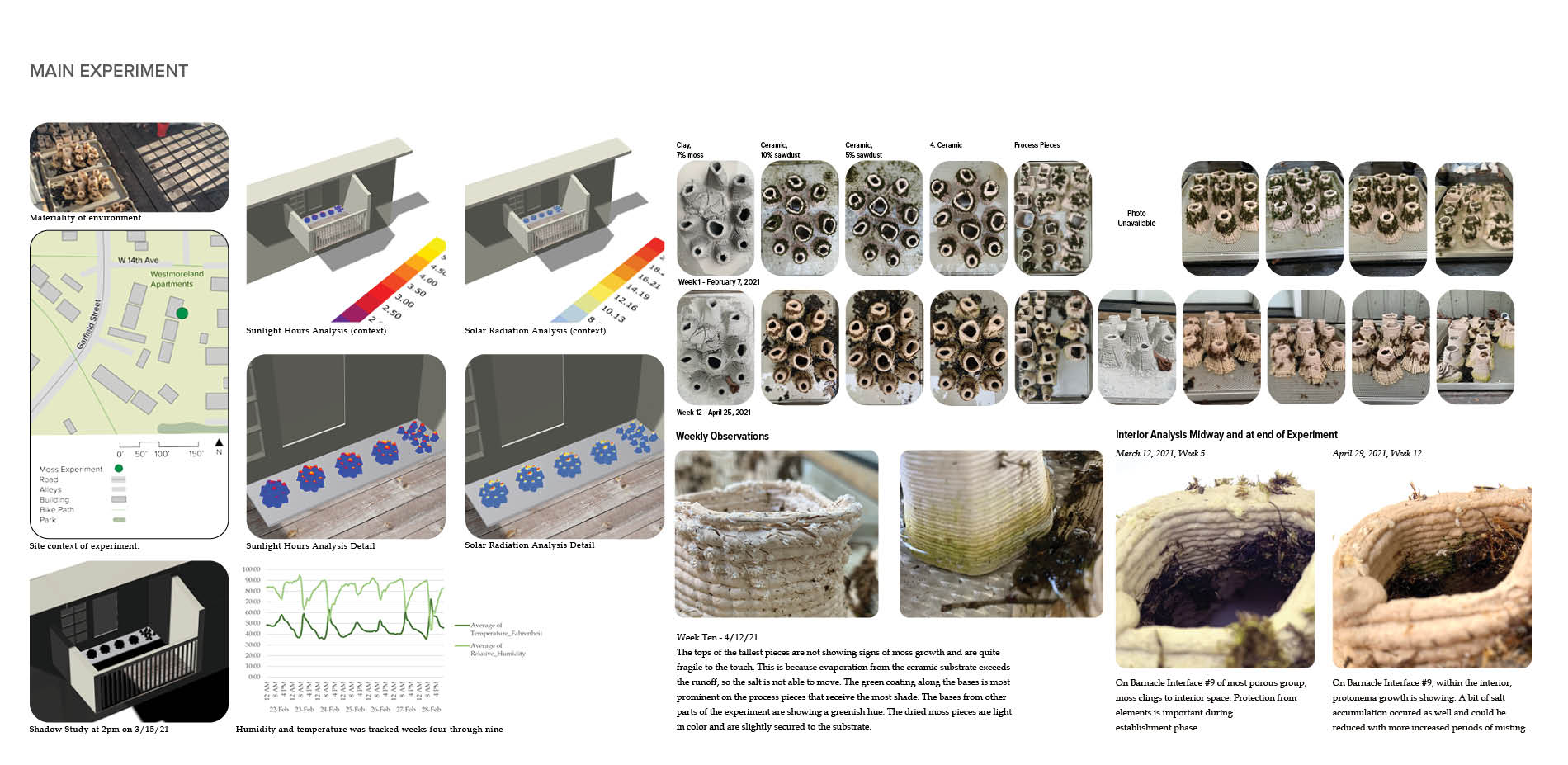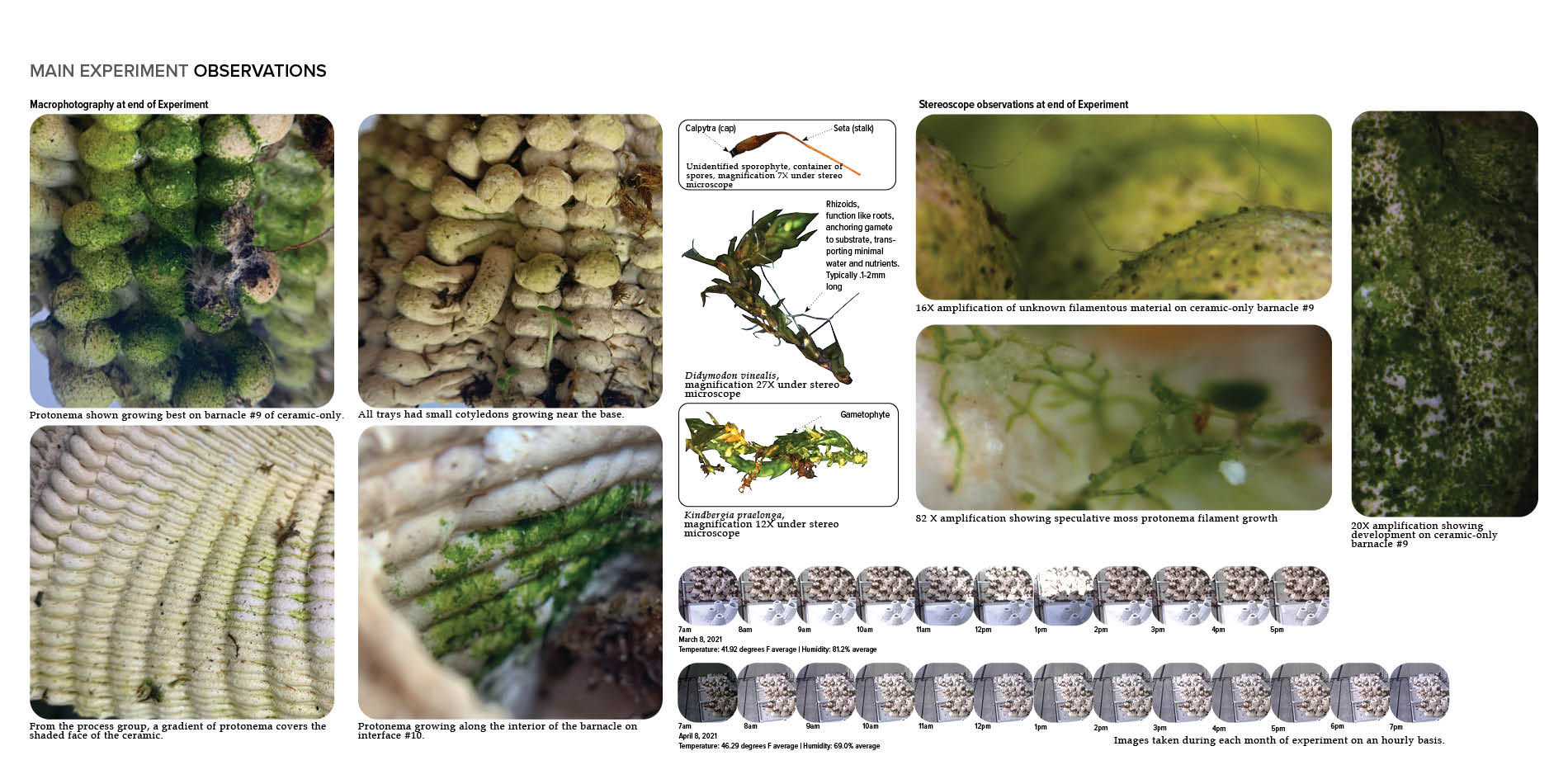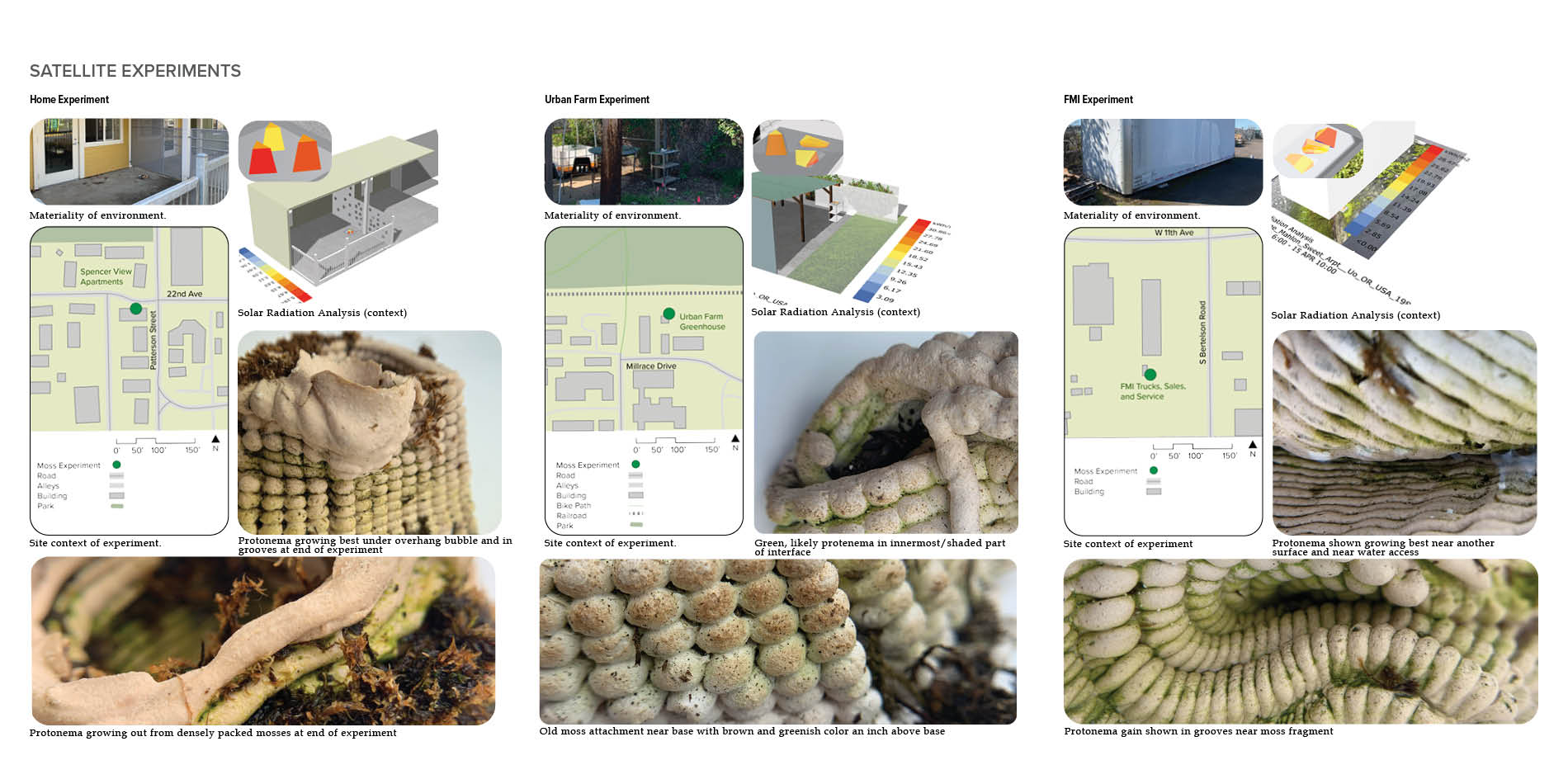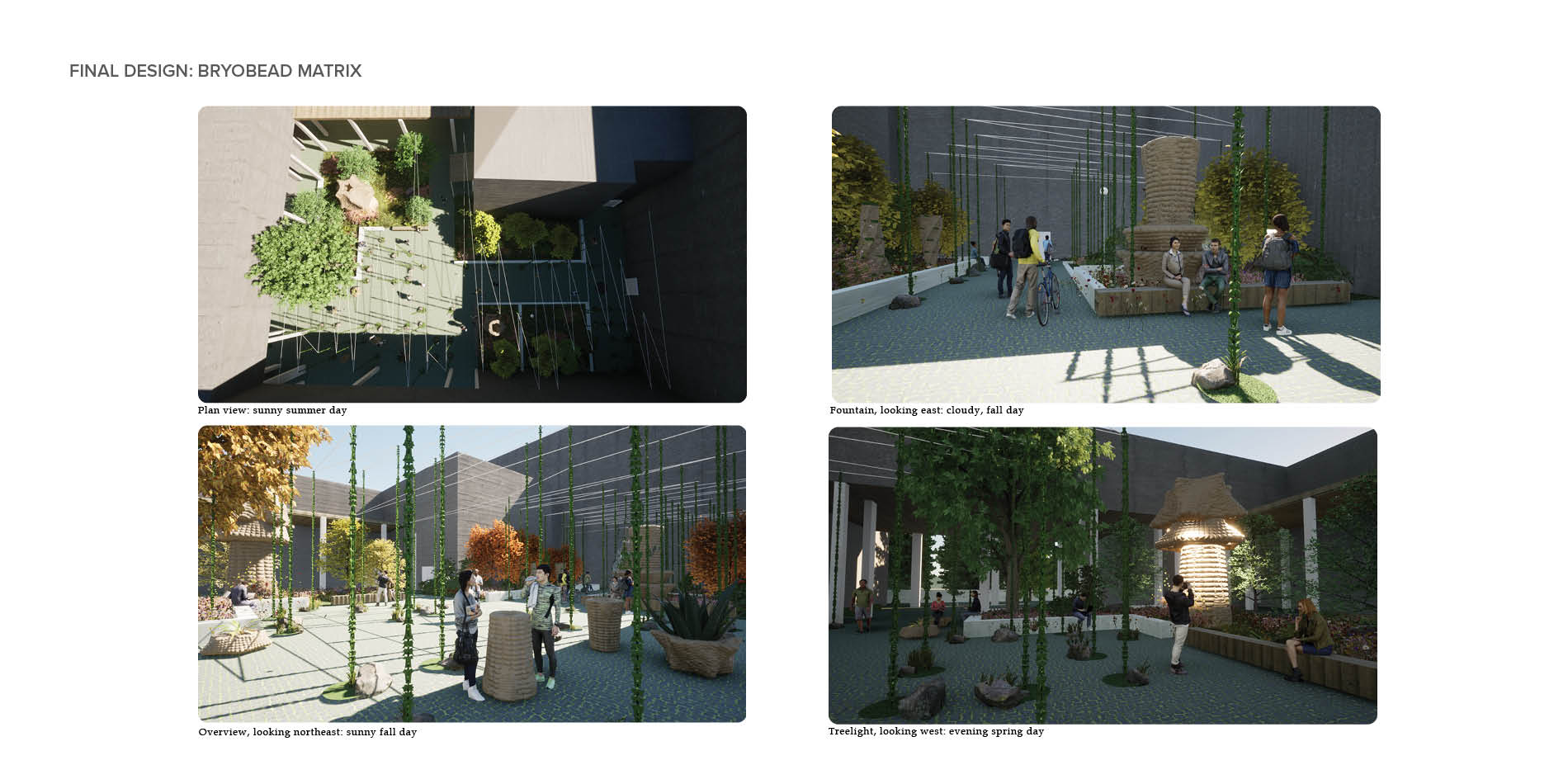Foreground for Mosses: Designing 3D Printed Clay Bryobricks to Enhance the Built Environment
Honor Award
Research
Eugene, Oregon, United States
Heather R. Tietz, Student ASLA
Faculty Advisors: David Buckley Borden, ASLA
University of Oregon
Printing with clay is no easy task, and this project uses the fabrication method to experiment with 3D-printed devices to create enhanced ecological habitats for mosses. They did a tremendous job of documenting their work, presenting the case for why landscape architects should be using these types of tools to prototype new devices and analysis. They lay out their data, and though it is simple, it is clear, well-presented, and valuable information for the profession.
- 2021 Awards Jury
Project Credits
Assistance with Scripting
Aaron Woolverton
Ignacio Lopez Buson
Mary Polites
Project Statement
This project explores the potential between the ecological services of mosses and designed ceramic substrate using 3D printing for creating ecologically enhanced landscapes. Communities and environments are negatively affected by areas with impervious surfaces and pollution. Typologies in landscape architecture, such as living walls, could be improved with mosses’ ecological benefits. This research-through-design approach interrogates the potential growth of mosses vis-a-vis experiments of 3D prints to create optimal substrates for propagating mosses. A framework for designing with mosses synthesized through the lessons learned during the experiment informed rapid prototyping through 3D printing with clay. The rapid prototyping phases inspired projective designs of a modular “bryobrick” screen system and columnar “bryobead” matrix. This research is award-worthy as it engages different aspects of scale, varying materials, and speculative typologies in landscape architecture. The results of the experiment show that moss grew best in low light and irrigated conditions on highly-grooved ceramic-only substrate. The outcome of the experiment serves as a proof of concept for designing with mosses and clay using emerging technology for creating performative landscapes.
Project Narrative
With rapid urbanization, increased pollution and impervious surfaces have compromised the health of urban ecosystems and led to the loss of cryptogamic cover such as mosses. The research question for this project asks, “How can we optimize the benefits of mosses by using innovative technologies such as 3D printing to design ceramic substrate to effect positive change in the built environment?” Clay is abundant, affordable, and accessible and can be reshaped rapidly and with control through additive manufacturing processes such as 3D printing to create bio-receptive surfaces in the built environment. An identifiable gap exists in the possibilities of designing with mosses in the built environment due to a lack of research and design of moss applications, especially in suitable climates such as the Pacific Northwest. This research recognizes the aim of living walls and green roofs but questions the efficacy of their high cost, off-gassing materials, and use of vascular plants, typically unsuitable to extreme conditions. There is potential to push the boundaries of these typologies to design with resilient, lightweight, and abundant mosses and the properties of clay to expand the possibilities of landscape architecture.
This research involved understanding the needs of mosses to design substrate forms in clay and ceramic material for testing propagation methods. Researching the benefits, properties, and historical applications of clay and ceramic was essential for understanding the design limitations. Learning tools for digital design and 3D printing technology was crucial for navigating workflows for translating ideas into digital models, physical outputs, and speculative design. Case studies and background research examined the themes of clay, moss, landscape/architecture, experiment, and 3D printing. Mosses were researched most deeply to understand their structure, lifecycle, benefits, propagation methods, ethnic uses. Using a stereoscope, mosses were identified and photographed. This information was compiled in a guide entitled “Foreground for Moss - Interface/Benefit Guide.”
Concurrent with research on mosses, design development for creating substrate interfaces began with analog drawing, modeling in Rhino, and advancing the grain of the surface parametrically in Grasshopper. The development of a Voronoi script created ten unique forms of varying heights, slopes, and aspects. A woven toolpath created a highly grooved substrate. This rapid prototyping process required responsive testing through 3D printing for generating successful, structurally sound substrates. Details of the process were recorded in a digital log. The final concept of the experimental substrates with conical, faceted form and tiling connection at the base share similarities to barnacles. The designed substrates for the experiment were therefore called barnacle interfaces.
The substrates designed for the experiments were composed of 7% moss and stoneware clay, 10% burned-out sawdust from ceramic, 5% burned-out sawdust from ceramic, ceramic-only, and process pieces. The substrates were composed of stoneware clay, and the ceramic was low-fired to cone 07 to increase porosity and was 6.8pH. The reason for designing with clay and ceramic was to test the mosses’ response to the porosity of the substrate. The collection of ten designed interfaces and ceramic process pieces for each type of substrate were set on a first-floor deck in a residential area in Eugene, Oregon. The trays were filled with water and misted weekly. Environmental conditions were tracked with a hygrometer and a time-lapse captured hourly photos. Rephotography using an iPhone and field notes tracked the weekly changes. In addition, three satellite experiments with three unique process interfaces were set up at the Urban Farm at the University of Oregon, at a residential site called “Home,” and in an industrial setting at FMI to further test the mosses’ response to different conditions. The sites were analyzed in Grasshopper for solar radiation and solar hours.
Midway through the experiment, rapid prototyping using an advanced 3D printer enabled more complex geometries. This work explored rainscreen systems and transitioned towards a freestanding, modular, bryobrick screen system. Bryobrick was a term generated with the idea that the substrates could stack and propagate mosses. The bryobricks were designed with pockets for holding water and mosses with increased surface area and shade. A tangential exploration explored the possibility of designing directly through clay with the ancient process of coil-building that emulated the digital weaving process. The clay form was photographed from many angles, and a mesh was created from the photos in Meshroom. This work was processed for 3D printing and scaled to a smaller size to create a successful rendering in 3D-printed clay.
Data generated from the experiment, rapid prototyping, and access to a primitive 3D printer informed the final speculative design work. The bryobricks were reduced to a smaller scale, and three unique beaded forms shared the language of a column; base, capital, and shaft. The designs were patterned using logical combinations to create three types of columns. The column with the most visually complex pattern was selected and analyzed for its spacing and rotation. The design was contextualized in a courtyard space at the University of Oregon and could apply to other urban spaces. The courtyard was analyzed for solar hours, and the columns were distributed in a matrix 5' on-center within areas receiving less than 3.5 hours of sunlight per day. This approach led to the typology of the bryobead matrix. The columns are 25’ tall, aligning with the column heights of the building. Gaps in the matrix created rooms within the courtyard space. A zig-zag irrigation pipe connected the tops of the columns, and a moss bed and rock at the base absorbed runoff. The beaded forms were scaled at 13.5X, 15X, and rotated 180 degrees to create benches, tables, a fountain, and light, respectively. An additional exercise using anemone in Grasshopper showed how other rapid design approaches could inform new 3D printed geometries.
Research through design was the primary method of inquiry used to explain the physical and aesthetic outcomes of the design. The experiment conducted falls under Nijhuis’s framework of setting up an experimental design in the form of a quasi-experiment. The individual experiments were analyzed through a meta-analysis under the comparative analysis phase. The analysis led to the development of a framework for the design study of the bryobead matrix. Under Lenzholzer’s research through design framework, the qualitative analysis to identify cause and effect are post-positivist, while most of this project falls under the constructivist category of assessing needs and generating new insights and knowledge.
Towards the end of monitoring the experiment, green filamentous protonema, the first stage of moss growth, was shown along the bases of the interfaces, under the packed fragmented moss, and within the interior spaces. The moss grew most successfully where there was more shade and more significant maintenance through irrigation. Exposing the barnacles to direct precipitation would have decreased evaporation and increased runoff, reducing the detrimental effect of salt crystal growth near the rims. With further monitoring and maintenance, this is proof that mosses can grow on 3D printed ceramic substrate.
A select number of projects were highlighted from a survey of case studies, including Mashrabiya 2.0 project by Forehand, Doyle, Hunt, and Senske, which explored 3D printing a ceramic screen and examining evaporative cooling properties. Unfortunately, it was challenging to find projects that covered moss, ceramics, experiment, 3D printing, and ceramic. A project by Klarenbeek and Dros proposed moss and clay sculptures near a highway in the Netherlands to assist with CO2 reduction and pollution absorption; however, more information is needed.
The artifacts, including rapid prototyping work and experiments, were on view for a one-evening collaborative exhibition called Foregrounding at the University of Oregon. Showing the physical result in person proved to be a sensory experience and presented new ideas. With further research and dissemination of this project, this insight can inform new approaches to designing with greater ecological efficiency across the field and scales of landscape architecture.
Plant List:
- Didymodon vinealis
- Ceratodon purpureus
- Syntrichia princeps
- Antitrichia californica
